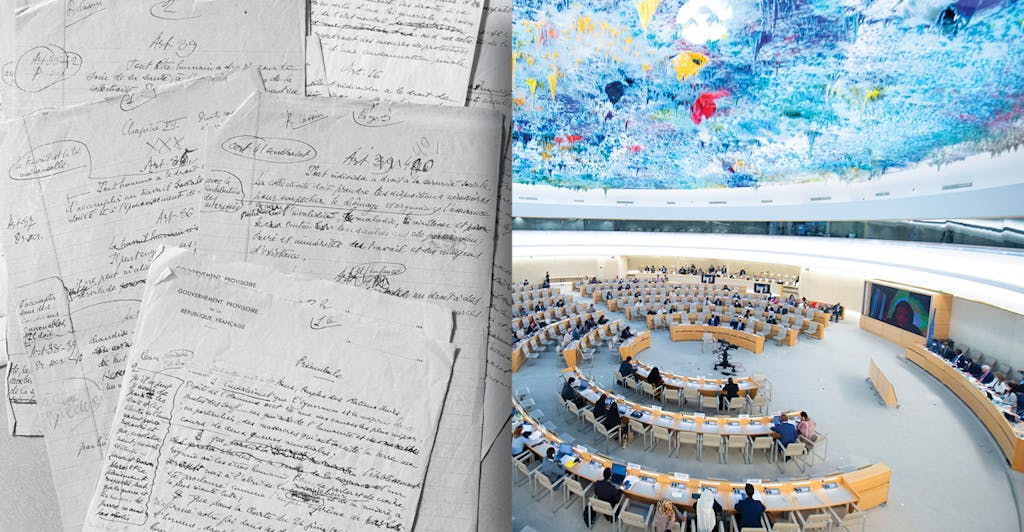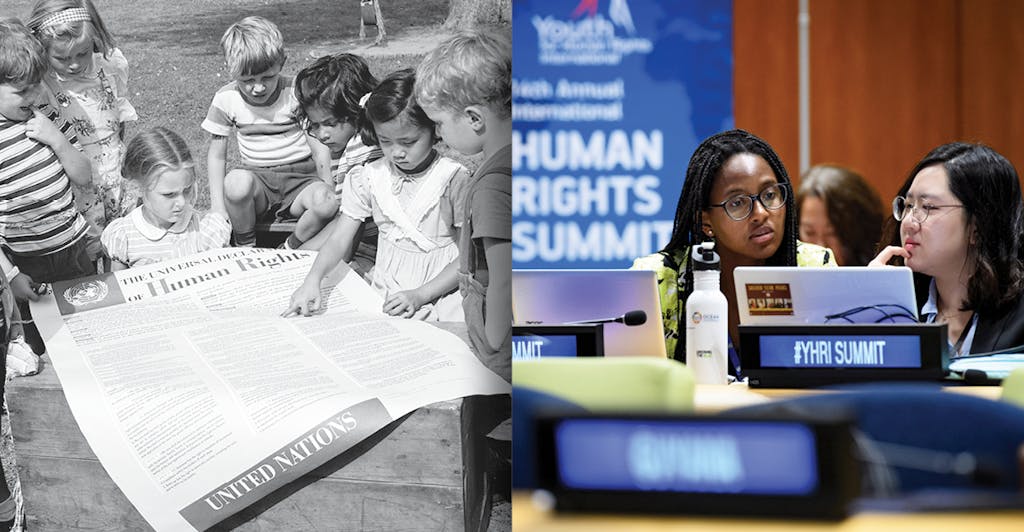


This year marks the 75th anniversary of the Universal Declaration of Human Rights — one of the first documents drafted by the United Nations that decreed, in writing, a radical truth: All people are born free and equal.
Like the United Nations itself, the Universal Declaration of Human Rights (UDHR) rose from the ashes of World War II. When it was adopted in 1948, much of the world was still recovering from the deadliest conflict in history, which claimed more than 60 million lives.
In the aftermath of such unprecedented death and destruction, the world turned to diplomacy to make sure history would not repeat itself. Nations came together for the first time to publicly declare the fundamental freedoms that belong to all of us. The UDHR contains 30 articles outlining our most basic birthrights, including protection against torture, inhumane treatment, cruel punishment, slavery, and servitude. The document heralded a new chapter of human history.
From consumer protections to child labor laws, we’ve made enormous strides in human rights over the past 75 years — and the Declaration has guided and grounded us throughout decades of revolutionary change in the fields of technology, medicine, political expression, and so much more.
“Human rights is a force to reckon with, not because it serves the interests of the powerful, but because it has captured the imagination of the powerless,” said UN High Commissioner for Human Rights Volker Türk, reflecting on the anniversary. “If there was ever a moment to rekindle the hope of human rights for every person, it is now.”
To commemorate this historic milestone, we’re sharing five key facts about the UDHR:

Left: Early drafts of the Declaration illustrate the complex and intense editing process that led to its adoption. Right: UN representatives convene during the milestone 50th Session of the Human Rights Council. The Council was launched to protect fundamental freedoms for all. Photo: UN Photo/Violaine Martin
1. The UDHR represented a pinnacle in global cooperation and representation.
Never before had so many people from different cultures and backgrounds united to draft a legal document. The two-year process involved representatives from a wide range of countries, including Australia, Canada, Chile, China, Egypt, France, Lebanon, the USSR, and the UK. On Dec. 10, 1948, it was adopted at the UN by 50 countries. Based on the diverse representation, the UDHR reflected and drew from a number of treatises, including the American Bill of Rights, the British Magna Carta, and the French Declaration of the Rights of Man.
The Declaration also benefited from unprecedented gender representation, with women shaping the UDHR in profound ways. Feminist leader Minerva Bernardino of the Dominican Republic, for example, is credited with the inclusion of “the equality of men and women” in the UDRH’s preamble. Begum Shaista Ikramullah of Pakistan, meanwhile, advocated for Article 16’s equal rights in marriage, which she viewed as a crucial way to help combat child marriage and forced marriage. For her part, Lakshmi Menon of India argued against colonial relativism that sought to deprive certain rights for those living under colonial rule.

Left: A group of Japanese citizens holds up the UDHR during a visit to the UN’s interim headquarters. Right: A protester in Australia stands up for refugee rights during a vigil for Human Rights Day on December 10th. Photo: UN Photo/Matt Hrkac
2. The Declaration challenged centuries of inhumane — and widely held — beliefs.
Slavery. Divine rule. Caste systems. Feudalism. Indentured servitude. It’s worth remembering that for most of human history the basic concept enshrined in Article 1 — “all human beings are born free and equal in dignity and rights” — was commonly contradicted in both principle and practice.
The UDHR acted as a catalyst for spreading and socializing the belief in equality and freedom for everyone, everywhere. It would take many years and many different movements worldwide for the wealthy and powerful to accept and recognize our most basic human rights.
3. It is the most translated document in the world.
The UDHR is now available in more than 500 languages. Besides the Bible or the Quran, few texts can claim such an impressive and influential reach. It has been signed by all 193 UN Member States.
The Declaration’s text lays out three cardinal principles: universality, indivisibility, and interdependence. In other words, human rights belong to all of us, cannot be ranked in importance, and cannot stand on their own.

Left: The cover of the UDHR booklet in four different languages; it is the most translated document in the world. Right: Students in South Africa during a protest for equal access to education. Photo: UN Photo/Tony Carr
4. It has served as the foundation for civil rights movements across the globe.
The Declaration’s 30 articles underpin international human rights law as we know it, providing the building blocks for the International Criminal Court and the legal groundwork for the tribunals that prosecuted war crimes in Rwanda and the former Yugoslavia.
In the past 75 years, the UDHR has also offered a playbook for young democracies and liberation movements across the globe. In South Africa, for example, activists drew inspiration and examples from the Declaration to argue for their rights in the courts of law and public opinion. According to the UN, it is widely recognized for inspiring more than 70 human rights treaties.
5. The UN launched a major yearlong initiative to reinvigorate the global human rights movement.
Through the Human Rights 75 initiative, UN officials spent the past year hearing from communities across the globe about the unique successes of and ongoing obstacles to freedom and equality. From the triple planetary crisis of pollution, global warming, and biodiversity loss to the rise in hate speech, disinformation, and polarization worldwide, we are facing complicated and interlinked issues that demand global cooperation. And one of the smartest ways to overcome these hurdles is to protect and strengthen liberty and equality, especially for the most vulnerable among us. Human rights are humanity’s best barometer against tyranny and suffering.
Safeguarding human rights won’t just help us address our shared challenges; it can also unlock progress and prosperity. In fact, 92% of targets for the Sustainable Development Goals are related to human rights treaties, according to the Danish Institute for Human Rights. The best way to achieve the 2030 Agenda is to invest time and resources into upholding one another’s dignity and worth.

Left: The children of UN staff members examine the UDHR shortly after its adoption. Right: Young people attend the International Human Rights Summit at the UN’s headquarters in New York. Photo: UN Photo
An Enduring and Evolving Movement
Throughout the past 75 years, the world’s views on human rights have continued to evolve — as do the challenges that threaten them. Today, we’re not only facing the horrors of conflict; we’re confronting the catastrophic effects of climate change alongside revolutionary leaps in technology that could pose serious risks to human rights worldwide if left unregulated.
This is why the UDHR exists: to ground and guide humanity during times of crisis and confusion. In our ongoing journey toward equality and freedom, the Declaration remains our North Star.
“Human rights are not a luxury that can be left until we find a solution to the world’s other problems,” UN Secretary-General António Guterres said earlier this year. “They are the solution to many of the world’s other problems. From the climate emergency to the misuse of technology, the answers to today’s crises are found in human rights.”
Though the Declaration was negotiated on a world stage, it is within our everyday lives that these most basic human rights are exercised.
“As we celebrate the impact of the Universal Declaration of Human Rights, our worst enemy is complacency,” Guterres said.
And while we can only guess what the world will look like 75 years from now, one truth will remain: Human rights belong to all of us, and each of us has a role to play in protecting them.
As we mark the 75th anniversary of the Universal Declaration for Human Rights, join the UN in taking a stand for human rights everywhere.